Muscle Insider
New member
Strength training is no longer a young person’s game. While professional athletes in most sports live out their glory days long before their 30th birthday, the landscape of strength sports spin a different tale. According to data from the World Raw Powerlifting Federation (WRPF) powerlifting popularity among Masters competitors (those age 4o and above) is growing. Fast. The...
The post Powerlifting Over 40: How to Start, Benefits, & More appeared first on BarBend.
Strength training is no longer a young person’s game. While professional athletes in most sports live out their glory days long before their 30th birthday, the landscape of strength sports spin a different tale.
According to data from the World Raw Powerlifting Federation (WRPF) powerlifting popularity among Masters competitors (those age 4o and above) is growing. Fast. The WRPF reported a seven percent increase in Masters enrollment between October and November of 2023 alone, and Masters athletes make up nearly a quarter of all athletes enrolled with the federation.
Powerlifting is gaining popularity for good reason, too. Beyond making you stronger than you’ve ever been, training for a strength sport can bolster your general health, inspire confidence, and immerse you in a culture of like-minded individuals with similar goals.
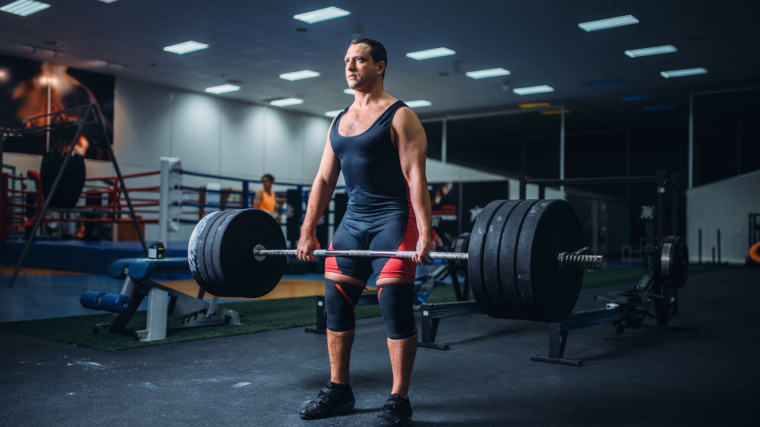
Credit: Nomad_Soul / Shutterstock
So if you’re over 40 and have been bitten by the barbell bug, you’re hardly alone. But let’s face facts: You might not be as spry or springy as you once were. Powerlifting is for everyone, but your entry as a middle to older adult might look a little different. Here’s what you need to know before, during, and after you get started.
Editor’s Note: The content on BarBend is meant to be informative in nature, but it should not be taken as medical advice. When starting a new training regimen and/or diet, it is always a good idea to consult with a trusted medical professional. We are not a medical resource. The opinions and articles on this site are not intended for use as diagnosis, prevention, and/or treatment of health problems. They are not substitutes for consulting a qualified medical professional.
What Is Powerlifting?
Before you get your hands on a barbell, you need to know the nomenclature. Powerlifting is a strength sport, which is exactly what it sounds like; a sport centered around testing an athlete’s strength-related capabilities through the lens of specific exercises.
In the case of powerlifting, athletes compete in three barbell-only disciplines — the back squat, bench press, and deadlift.
Powerlifters enroll with and compete in a variety of different federations, which govern the sport from the local to international level. Different federations have their own rulesets regarding lift-specific techniques as well as what types of equipment may be used.
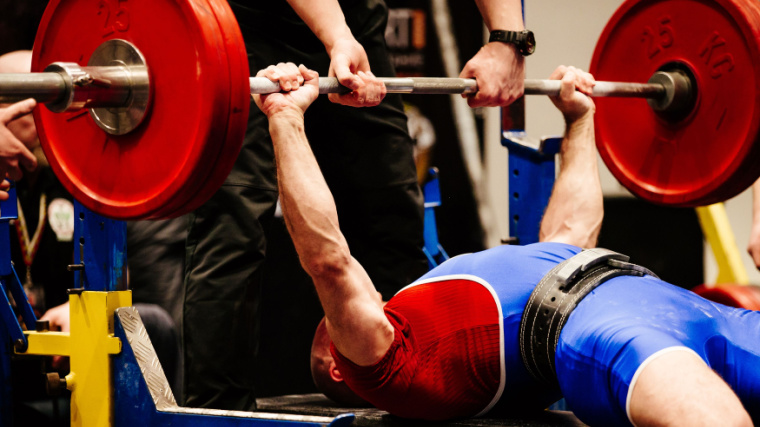
Credit: Real Sports Photos / Shutterstock
[Read More: Powerlifting Weight Classes Across Federations (Infographic)]
You don’t necessarily need to compete in order to train for powerlifting, but most powerlifters have competitive aspirations at some point. To maintain a level playing field, all powerlifting federations have age brackets. Athletes above 40 years of age (varies by federation) are considered Masters competitors and lift against peers who fall within a similar age range. For example, here are the Masters categories within the International Powerlifting Federation (IPF):
How to Start Powerlifting After 40
Getting started with powerlifting is simple, but not necessarily easy in all cases. It’s not as straightforward as lacing up your running shoes and hitting the track for a jog.
What You’ll Need
All sports have a level of buy-in before you can get involved. On one end, something like frisbee is pretty bare-bones. All you need is a disc and an open field. On the other hand, sports like free solo climbing or bowling require more specialized equipment or facilities.
[Read More: 10 Incredibly Useful Powerlifting Tips]
Powerlifting falls somewhere in the middle. You can technically do it anywhere, as long as you have access to the right equipment and enough time to train. Here’s a brief rundown of what you’ll need before you start:
Step 1 — Assess Yourself
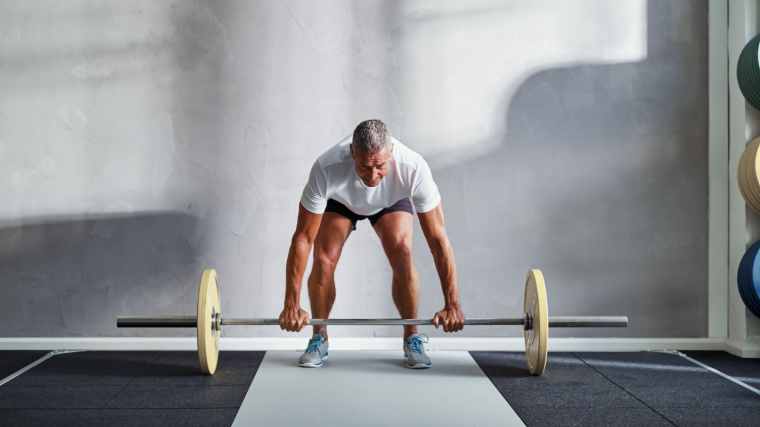
Credit: Ground Picture / Shutterstock
[Read More: The 8 Best Lifting Straps You Can Buy]
This applies to anyone beginning a new athletic pursuit but goes double if you’re pushing (or have passed) 40. Powerlifting requires moderate ranges of motion in the hips, knees, and shoulders primarily.
You should also consult a physician and make note of any medical conditions that may prevent you from working with weights consistently. If you have a thumbs-up from your doctor and decent mobility (you’ll need to be able to squat with your thighs parallel to the floor as a powerlifting), you’re ready to get going.
Step 2 — Get a Program (Or a Coach)
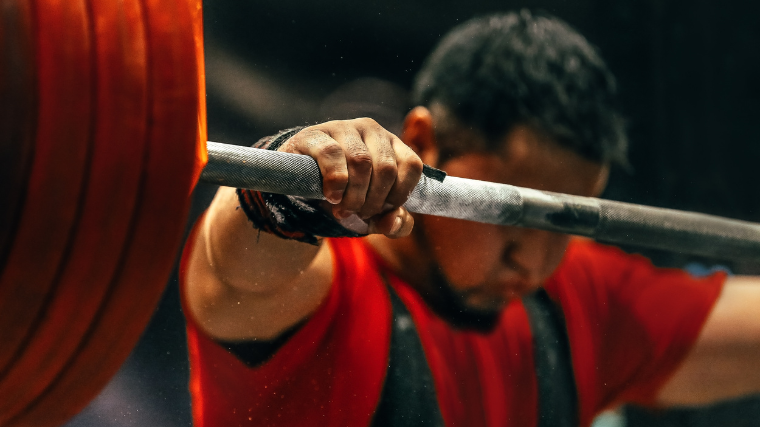 Credit: sportpoint / Shutterstock
Credit: sportpoint / Shutterstock
Powerlifting is a structured, repetitive sport. Gains are made in small, consistent increments, and this is doubly true for older adults who no longer have access to the embarrassment of athletic prowess that is puberty.
As such, you’ll need a pre-written, or periodized, strength training program to ensure that you’re on the right path during your powerlifting journey. Luckily, there are plenty of solid beginner powerlifting workout routines out there to pick from. Some popular options include:
Step 3 — Start, Slowly
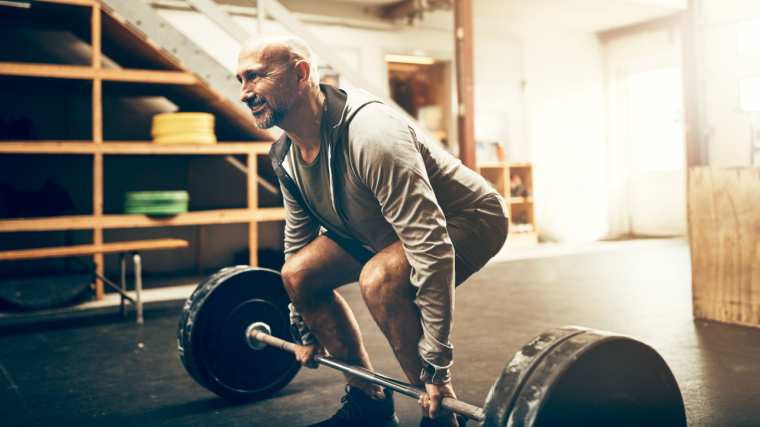
Credit: Ground Picture / Shutterstock
[Read More: The 6 Best Barbell Collars On The Market]
People in their teens, 20s, or even 30s can tolerate tough exercise variations better than older adults on average. For you, this means taking it slow in the gym with your powerlifting training at the onset.
Perform your powerlifting workouts as written, but don’t rush to find your 1-rep max right away. Prioritize your technique and err on the side of caution when selecting your weights.
If you’re already familiar with weight lifting, the Rate of Perceived Exertion, or RPE scale, can be a useful tool here. Until you acclimate to the physical demands of powerlifting, keep most of your sets below an RPE of seven or eight.
Benefits of Powerlifting for Older Adults
The benefits of powerlifting extend far beyond “just” making you stronger. In fact, that’s really just the tip of the iceberg. These benefits aren’t exclusive to anyone in the 40-and-up cohort, but they may be of particular relevance to you if you fall into that category.
Great for General Health
Any form of physical activity — powerlifting is no exception here — will benefit your general health in a number of different ways. Research indicates that resistance training (powerlifting falls under this umbrella) can improve executive function, cognitive ability, blood pressure, and much more. (1)
Many of these benefits were once thought to be the exclusive province of cardiovascular exercise, but contemporary research has illustrated that working with the barbell can be similarly effective.
Build Muscular Strength
Powerlifting’s calling card is that it tests your strength. But in order to test strength, you need to build it in the first place. Stronger muscles help you move more weight, sure, but they’re also integral in preventing and managing age-related conditions like sarcopenia or frailty.
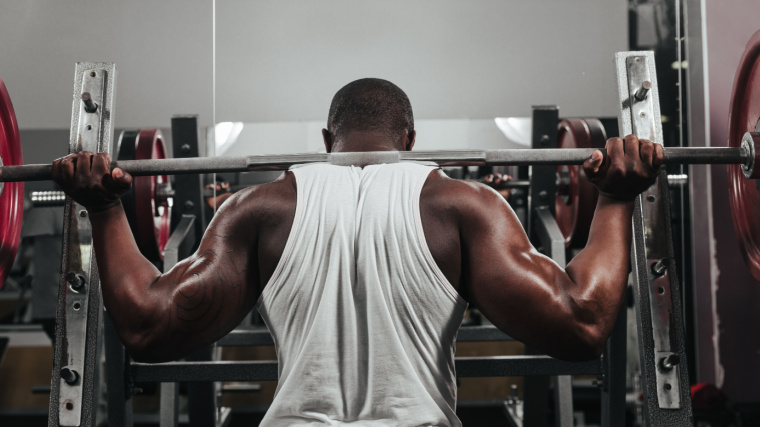
Credit: Ivan Kochergin / Shutterstock
[Read More: Does Powerlifting Build Muscle?]
Studies repeatedly show that strength training is a potent way of ensuring your body remains robust and resilient into late adulthood. Some scientists draw strong correlations between improving nervous system function and motor control (both of which you train in powerlifting) and the prevention of muscle loss. (2)
Improve Bone Density
Resistance training (that is, lifting weights) is one of the most reliable methods of maintaining bone mineral density, particularly in older populations who are at risk of suffering osteoporosis or other related conditions.
The forces applied to your skeletal system during a powerlifting workout strengthen and harden your bones. As such, clinicians commonly recommend resistance training as a form of preventative care to maintain strong bones into old age. (3)(4)
Social & Competitive Interaction
This one tends to fly under the radar, but it deserves to have its praises sung all the same. Despite powerlifting being a solo sport (you don’t usually compete as part of a team), it still brings with it plenty of social benefits.
Many older adults report increasing feelings of social isolation or loneliness, which can lead to or worsen depression or other psychological conditions. (5) While powerlifting is certainly not a substitute for mental health care, there’s a strong sense of camaraderie to the sport, especially if you join a powerlifting-focused gym.
[Read More: 8 Common Powerlifting Mistakes and How to Fix Them]
Training for powerlifting can be therapeutic for both your body and mind, providing you with a social network of like-minded peers from a wide variety of backgrounds. At competitions, you’re also likely to make some new friends both on and off the platform.
Tips From a Masters Competitor
If you’re not sold on powerlifting just yet, it might help to hear from a lifelong lifter who recently picked up the sport full-time. BarBend’s own Roger Lockridge, a remote correspondent and 25-year veteran gymgoer, recently partook in his first powerlifting meet at age 42.
View this post on Instagram A post shared by Roger "Rock" Lockridge (@rocklockridge)
[/quote]
[Related: I Competed in My First Powerlifting Meet at Age 42 — Here’s How It Went]
Don’t Go It Alone
Almost all powerlifters rely on coaching in some capacity, and Lockridge was no exception. “I didn’t work with a coach this time, but I did seek advice from other powerlifters. I know my body pretty well, but I do think I will seek out a coach for my next competition.”
If you don’t have many years of training under your belt, the objective eye of a powerlifting coach can be an invaluable asset.
Be Conservative in the Gym
Lockridge also did a majority of his training at his home gym, and he credits the lack of spotters for keeping his workouts safe and sustainable. “I wasn’t able to push myself with extreme weights. This actually helped me, because I stayed safe and suffered no injuries while preparing for my competition.”
Aim for Fun
“To new powerlifters over 40, I would suggest that the only expectation they set for themselves is to have fun,” Lockridge says. “Go in [to a powerlifting meet] with the goal of enjoying yourself. The experience will be enough to propel you to move forward with future meets as you continue your athletic career.”
Lockridge competed in the WRPF’s West Virginia Legacy Fall Open meet in September of 2023. At 42 years old, he achieved the following best lifts:
FAQs
Powerlifting is a marathon, not a sprint. If you’re over 40 and interested in getting started with the sport, these common questions might put your fears to rest:
Is powerlifting safe if you’re over 40?Absolutely. While all athletic endeavors carry a degree of risk, powerlifting injury rates are far lower than many other more popular sports. (6) If you start slowly and progress conservatively within the bounds of your ability, powerlifting is in no way dangerous.
What are the age categories in powerlifting?Powerlifting federations have different age brackets. The International Powerlifting Federation groups its Masters athletes into ten-year brackets beginning at age 40 all the way up to the 70-years-and-up division.
Can you do powerlifting after 40?Powerlifting is absolutely a good idea for people over 40. It can help maintain muscle mass, stave off bone degeneration, and improve confidence. You may have to make certain concessions that a younger individual wouldn’t (think how often and how hard you hit the gym), but it’s definitely a worthwhile pursuit.
{"@context":"https://schema.org","@type":"FAQPage","mainEntity":[{"@type":"Question","name":"Is powerlifting safe if youu2019re over 40?","acceptedAnswer":{"@type":"Answer","text":"Absolutely. While all athletic endeavors carry a degree of risk, powerlifting injury rates are far lower than many other more popular sports. (6) If you start slowly and progress conservatively within the bounds of your ability, powerlifting is in no way dangerous.
n"}},{"@type":"Question","name":"What are the age categories in powerlifting?","acceptedAnswer":{"@type":"Answer","text":"Powerlifting federations have different age brackets. The International Powerlifting Federation groups its Masters athletes into ten-year brackets beginning at age 40 all the way up to the 70-years-and-up division.
n"}},{"@type":"Question","name":"Can you do powerlifting after 40?","acceptedAnswer":{"@type":"Answer","text":"Powerlifting is absolutely a good idea for people over 40. It can help maintain muscle mass, stave off bone degeneration, and improve confidence. You may have to make certain concessions that a younger individual wouldnu2019t (think how often and how hard you hit the gym), but itu2019s definitely a worthwhile pursuit.
n"}}]}
References
[*]Westcott W. L. (2012). Resistance training is medicine: effects of strength training on health. Current sports medicine reports, 11(4), 209–216.
[*]Nascimento, C. M., Ingles, M., Salvador-Pascual, A., Cominetti, M. R., Gomez-Cabrera, M. C., & Viña, J. (2019). Sarcopenia, frailty and their prevention by exercise. Free radical biology & medicine, 132, 42–49.
[*]Massini DA, Nedog FH, de Oliveira TP, Almeida TAF, Santana CAA, Neiva CM, Macedo AG, Castro EA, Espada MC, Santos FJ, Pessôa Filho DM. The Effect of Resistance Training on Bone Mineral Density in Older Adults: A Systematic Review and Meta-Analysis. Healthcare (Basel). 2022 Jun 17;10(6):1129. doi: 10.3390/healthcare10061129. PMID: 35742181; PMCID: PMC9222380.
[*]Karlamangla, A. S., Shieh, A., & Greendale, G. A. (2021). Hormones and bone loss across the menopause transition. Vitamins and hormones, 115, 401–417.
[*]Freedman A, Nicolle J. Social isolation and loneliness: the new geriatric giants: Approach for primary care. Can Fam Physician. 2020 Mar;66(3):176-182. PMID: 32165464; PMCID: PMC8302356.
[*]Patton, Andrew. What I Learned About Injury Rates from Surveying 1,900 Powerlifters. Stronger By Science.
Editor’s Note: BarBend maintains an official Media Partnership with the World Raw Powerlifting Federation Americas. The two organizations maintain editorial independence unless otherwise specified on specific projects.
Featured Image: Nomad_Soul / Shutterstock
The post Powerlifting Over 40: How to Start, Benefits, & More appeared first on BarBend.
Click here to view the article.
The post Powerlifting Over 40: How to Start, Benefits, & More appeared first on BarBend.
Strength training is no longer a young person’s game. While professional athletes in most sports live out their glory days long before their 30th birthday, the landscape of strength sports spin a different tale.
According to data from the World Raw Powerlifting Federation (WRPF) powerlifting popularity among Masters competitors (those age 4o and above) is growing. Fast. The WRPF reported a seven percent increase in Masters enrollment between October and November of 2023 alone, and Masters athletes make up nearly a quarter of all athletes enrolled with the federation.
Powerlifting is gaining popularity for good reason, too. Beyond making you stronger than you’ve ever been, training for a strength sport can bolster your general health, inspire confidence, and immerse you in a culture of like-minded individuals with similar goals.

Credit: Nomad_Soul / Shutterstock
So if you’re over 40 and have been bitten by the barbell bug, you’re hardly alone. But let’s face facts: You might not be as spry or springy as you once were. Powerlifting is for everyone, but your entry as a middle to older adult might look a little different. Here’s what you need to know before, during, and after you get started.
Editor’s Note: The content on BarBend is meant to be informative in nature, but it should not be taken as medical advice. When starting a new training regimen and/or diet, it is always a good idea to consult with a trusted medical professional. We are not a medical resource. The opinions and articles on this site are not intended for use as diagnosis, prevention, and/or treatment of health problems. They are not substitutes for consulting a qualified medical professional.
What Is Powerlifting?
Before you get your hands on a barbell, you need to know the nomenclature. Powerlifting is a strength sport, which is exactly what it sounds like; a sport centered around testing an athlete’s strength-related capabilities through the lens of specific exercises.
In the case of powerlifting, athletes compete in three barbell-only disciplines — the back squat, bench press, and deadlift.
Powerlifters enroll with and compete in a variety of different federations, which govern the sport from the local to international level. Different federations have their own rulesets regarding lift-specific techniques as well as what types of equipment may be used.

Credit: Real Sports Photos / Shutterstock
[Read More: Powerlifting Weight Classes Across Federations (Infographic)]
You don’t necessarily need to compete in order to train for powerlifting, but most powerlifters have competitive aspirations at some point. To maintain a level playing field, all powerlifting federations have age brackets. Athletes above 40 years of age (varies by federation) are considered Masters competitors and lift against peers who fall within a similar age range. For example, here are the Masters categories within the International Powerlifting Federation (IPF):
- 40-49
- 50-59
- 60-69
- 70+
How to Start Powerlifting After 40
Getting started with powerlifting is simple, but not necessarily easy in all cases. It’s not as straightforward as lacing up your running shoes and hitting the track for a jog.
What You’ll Need
All sports have a level of buy-in before you can get involved. On one end, something like frisbee is pretty bare-bones. All you need is a disc and an open field. On the other hand, sports like free solo climbing or bowling require more specialized equipment or facilities.
[Read More: 10 Incredibly Useful Powerlifting Tips]
Powerlifting falls somewhere in the middle. You can technically do it anywhere, as long as you have access to the right equipment and enough time to train. Here’s a brief rundown of what you’ll need before you start:
- Time: Most powerlifters work out between three and six times per week. On average, powerlifting training sessions take between one and two hours in total.
- Space: To train for powerlifting, you’ll need a barbell, weight plates, a squat rack, and a deadlift platform or flooring that is designed to tolerate dropping heavy bars.
- Stuff: You can train for powerlifting in normal athletic clothing, just make sure it is loose enough to not inhibit movement. Supportive gear like knee sleeves, wrist wraps, or a lifting belt can help as well. If you decide to compete, you’ll need a singlet.
Step 1 — Assess Yourself

Credit: Ground Picture / Shutterstock
[Read More: The 8 Best Lifting Straps You Can Buy]
This applies to anyone beginning a new athletic pursuit but goes double if you’re pushing (or have passed) 40. Powerlifting requires moderate ranges of motion in the hips, knees, and shoulders primarily.
You should also consult a physician and make note of any medical conditions that may prevent you from working with weights consistently. If you have a thumbs-up from your doctor and decent mobility (you’ll need to be able to squat with your thighs parallel to the floor as a powerlifting), you’re ready to get going.
Step 2 — Get a Program (Or a Coach)

Powerlifting is a structured, repetitive sport. Gains are made in small, consistent increments, and this is doubly true for older adults who no longer have access to the embarrassment of athletic prowess that is puberty.
As such, you’ll need a pre-written, or periodized, strength training program to ensure that you’re on the right path during your powerlifting journey. Luckily, there are plenty of solid beginner powerlifting workout routines out there to pick from. Some popular options include:
- The 5×5 Workout Plan
- Starting Strength
- The Texas Method
- The Cube Method
Step 3 — Start, Slowly

Credit: Ground Picture / Shutterstock
[Read More: The 6 Best Barbell Collars On The Market]
People in their teens, 20s, or even 30s can tolerate tough exercise variations better than older adults on average. For you, this means taking it slow in the gym with your powerlifting training at the onset.
Perform your powerlifting workouts as written, but don’t rush to find your 1-rep max right away. Prioritize your technique and err on the side of caution when selecting your weights.
If you’re already familiar with weight lifting, the Rate of Perceived Exertion, or RPE scale, can be a useful tool here. Until you acclimate to the physical demands of powerlifting, keep most of your sets below an RPE of seven or eight.
Benefits of Powerlifting for Older Adults
The benefits of powerlifting extend far beyond “just” making you stronger. In fact, that’s really just the tip of the iceberg. These benefits aren’t exclusive to anyone in the 40-and-up cohort, but they may be of particular relevance to you if you fall into that category.
Great for General Health
Any form of physical activity — powerlifting is no exception here — will benefit your general health in a number of different ways. Research indicates that resistance training (powerlifting falls under this umbrella) can improve executive function, cognitive ability, blood pressure, and much more. (1)
Many of these benefits were once thought to be the exclusive province of cardiovascular exercise, but contemporary research has illustrated that working with the barbell can be similarly effective.
Build Muscular Strength
Powerlifting’s calling card is that it tests your strength. But in order to test strength, you need to build it in the first place. Stronger muscles help you move more weight, sure, but they’re also integral in preventing and managing age-related conditions like sarcopenia or frailty.

Credit: Ivan Kochergin / Shutterstock
[Read More: Does Powerlifting Build Muscle?]
Studies repeatedly show that strength training is a potent way of ensuring your body remains robust and resilient into late adulthood. Some scientists draw strong correlations between improving nervous system function and motor control (both of which you train in powerlifting) and the prevention of muscle loss. (2)
Improve Bone Density
Resistance training (that is, lifting weights) is one of the most reliable methods of maintaining bone mineral density, particularly in older populations who are at risk of suffering osteoporosis or other related conditions.
The forces applied to your skeletal system during a powerlifting workout strengthen and harden your bones. As such, clinicians commonly recommend resistance training as a form of preventative care to maintain strong bones into old age. (3)(4)
Social & Competitive Interaction
This one tends to fly under the radar, but it deserves to have its praises sung all the same. Despite powerlifting being a solo sport (you don’t usually compete as part of a team), it still brings with it plenty of social benefits.
Many older adults report increasing feelings of social isolation or loneliness, which can lead to or worsen depression or other psychological conditions. (5) While powerlifting is certainly not a substitute for mental health care, there’s a strong sense of camaraderie to the sport, especially if you join a powerlifting-focused gym.
[Read More: 8 Common Powerlifting Mistakes and How to Fix Them]
Training for powerlifting can be therapeutic for both your body and mind, providing you with a social network of like-minded peers from a wide variety of backgrounds. At competitions, you’re also likely to make some new friends both on and off the platform.
Tips From a Masters Competitor
If you’re not sold on powerlifting just yet, it might help to hear from a lifelong lifter who recently picked up the sport full-time. BarBend’s own Roger Lockridge, a remote correspondent and 25-year veteran gymgoer, recently partook in his first powerlifting meet at age 42.
View this post on Instagram A post shared by Roger "Rock" Lockridge (@rocklockridge)
[/quote]
[Related: I Competed in My First Powerlifting Meet at Age 42 — Here’s How It Went]
Don’t Go It Alone
Almost all powerlifters rely on coaching in some capacity, and Lockridge was no exception. “I didn’t work with a coach this time, but I did seek advice from other powerlifters. I know my body pretty well, but I do think I will seek out a coach for my next competition.”
If you don’t have many years of training under your belt, the objective eye of a powerlifting coach can be an invaluable asset.
Be Conservative in the Gym
Lockridge also did a majority of his training at his home gym, and he credits the lack of spotters for keeping his workouts safe and sustainable. “I wasn’t able to push myself with extreme weights. This actually helped me, because I stayed safe and suffered no injuries while preparing for my competition.”
Aim for Fun
“To new powerlifters over 40, I would suggest that the only expectation they set for themselves is to have fun,” Lockridge says. “Go in [to a powerlifting meet] with the goal of enjoying yourself. The experience will be enough to propel you to move forward with future meets as you continue your athletic career.”
Lockridge competed in the WRPF’s West Virginia Legacy Fall Open meet in September of 2023. At 42 years old, he achieved the following best lifts:
- Squat: 325.2 pounds
- Bench Press: 319.7 pounds
- Deadlift: 358.3 pounds
- Total: 1,003.2 pounds
FAQs
Powerlifting is a marathon, not a sprint. If you’re over 40 and interested in getting started with the sport, these common questions might put your fears to rest:
Is powerlifting safe if you’re over 40?Absolutely. While all athletic endeavors carry a degree of risk, powerlifting injury rates are far lower than many other more popular sports. (6) If you start slowly and progress conservatively within the bounds of your ability, powerlifting is in no way dangerous.
What are the age categories in powerlifting?Powerlifting federations have different age brackets. The International Powerlifting Federation groups its Masters athletes into ten-year brackets beginning at age 40 all the way up to the 70-years-and-up division.
Can you do powerlifting after 40?Powerlifting is absolutely a good idea for people over 40. It can help maintain muscle mass, stave off bone degeneration, and improve confidence. You may have to make certain concessions that a younger individual wouldn’t (think how often and how hard you hit the gym), but it’s definitely a worthwhile pursuit.
{"@context":"https://schema.org","@type":"FAQPage","mainEntity":[{"@type":"Question","name":"Is powerlifting safe if youu2019re over 40?","acceptedAnswer":{"@type":"Answer","text":"Absolutely. While all athletic endeavors carry a degree of risk, powerlifting injury rates are far lower than many other more popular sports. (6) If you start slowly and progress conservatively within the bounds of your ability, powerlifting is in no way dangerous.
n"}},{"@type":"Question","name":"What are the age categories in powerlifting?","acceptedAnswer":{"@type":"Answer","text":"Powerlifting federations have different age brackets. The International Powerlifting Federation groups its Masters athletes into ten-year brackets beginning at age 40 all the way up to the 70-years-and-up division.
n"}},{"@type":"Question","name":"Can you do powerlifting after 40?","acceptedAnswer":{"@type":"Answer","text":"Powerlifting is absolutely a good idea for people over 40. It can help maintain muscle mass, stave off bone degeneration, and improve confidence. You may have to make certain concessions that a younger individual wouldnu2019t (think how often and how hard you hit the gym), but itu2019s definitely a worthwhile pursuit.
n"}}]}
References
[*]Westcott W. L. (2012). Resistance training is medicine: effects of strength training on health. Current sports medicine reports, 11(4), 209–216.
[*]Nascimento, C. M., Ingles, M., Salvador-Pascual, A., Cominetti, M. R., Gomez-Cabrera, M. C., & Viña, J. (2019). Sarcopenia, frailty and their prevention by exercise. Free radical biology & medicine, 132, 42–49.
[*]Massini DA, Nedog FH, de Oliveira TP, Almeida TAF, Santana CAA, Neiva CM, Macedo AG, Castro EA, Espada MC, Santos FJ, Pessôa Filho DM. The Effect of Resistance Training on Bone Mineral Density in Older Adults: A Systematic Review and Meta-Analysis. Healthcare (Basel). 2022 Jun 17;10(6):1129. doi: 10.3390/healthcare10061129. PMID: 35742181; PMCID: PMC9222380.
[*]Karlamangla, A. S., Shieh, A., & Greendale, G. A. (2021). Hormones and bone loss across the menopause transition. Vitamins and hormones, 115, 401–417.
[*]Freedman A, Nicolle J. Social isolation and loneliness: the new geriatric giants: Approach for primary care. Can Fam Physician. 2020 Mar;66(3):176-182. PMID: 32165464; PMCID: PMC8302356.
[*]Patton, Andrew. What I Learned About Injury Rates from Surveying 1,900 Powerlifters. Stronger By Science.
Editor’s Note: BarBend maintains an official Media Partnership with the World Raw Powerlifting Federation Americas. The two organizations maintain editorial independence unless otherwise specified on specific projects.
Featured Image: Nomad_Soul / Shutterstock
The post Powerlifting Over 40: How to Start, Benefits, & More appeared first on BarBend.
Click here to view the article.

